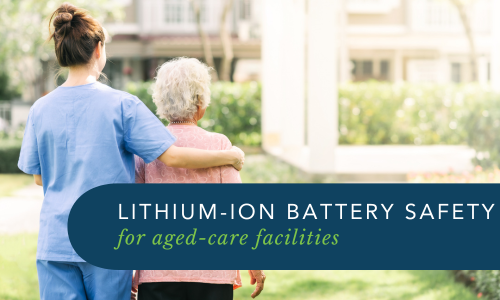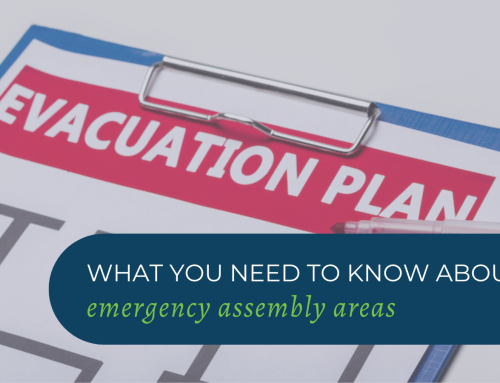Lithium-ion batteries power countless everyday devices that make life easier in aged-care settings, but they’re also an increasingly common fire risk. This blog explains which items use these batteries, why vigilance is necessary, the warning signs of a failing battery, how to care for devices, safe disposal, what to do if a battery fire starts, and how Workplace Emergency Management (WEM) can help aged-care providers prepare and respond.
Common Lithium-ion Items You Will Find in Aged-Care Facilities
Many items in resident rooms, staff areas and facility maintenance stores contain lithium-ion cells, including:
- Mobile phones, tablets and laptops used by staff, visitors and residents.
- Cordless phones, power tools and battery-powered vacuum cleaners used by maintenance and housekeeping.
- Mobility aids (modern mobility scooters and electric wheelchairs often use lithium batteries)
- Power banks and battery chargers.
- Portable medical and assistive devices, some models of portable oxygen concentrators, monitoring equipment and communication aids use lithium-ion batteries.
Because batteries are in both personal items and facility equipment, a risk can come from many places, not just the facility’s own devices. Fire services in Australia have repeatedly warned that e-bikes, e-scooters and similar devices are behind a growing number of battery fires. (ABC Net)
Why You Need To Be Vigilant
Lithium-ion batteries can undergo thermal runaway: a defect, damage, overcharging or manufacturing fault causes one cell to overheat, releasing heat that can cause adjacent cells to ignite. Fires from thermal runaway can be rapid, produce intense heat, explosive venting and toxic smoke, and can reignite after being apparently extinguished, making them particularly dangerous in places with vulnerable residents.
Warning Signs To Watch For
If you spot any of these with a battery or device, treat it seriously:
- Battery swelling, bulging or deformation.
- Excessive heat from a device while charging or immediately after use.
- Strange smells (chemical or sweet/peppery odors), sizzling, popping or hissing noises.
- Smoke, sparks, or small flames from a battery or device.
- Frequent or rapid battery depletion and inability to hold charge (may indicate internal damage).
If you observe any of the above, unplug the device (if safe), isolate it on a non-combustible surface, and get expert advice, do not continue to use or charge it!
Caring For Devices With Lithium Batteries
Practical, low-cost habits reduce risk:
- Use the manufacturer’s charger and replace chargers that show wear. Avoid makeshift charging rigs.
- Charge on hard, non-combustible surfaces (tiles, concrete) and away from bedding or paper. Don’t charge devices unattended overnight.
- Avoid extreme temperatures, don’t leave devices in hot rooms, direct sun, or in freezing conditions.
- Inspect devices regularly for damage, swelling or exposed wiring and retire visibly damaged batteries/devices.
- Limit simultaneous charging of many high-capacity devices in one small space. Spread charging or use purpose-built charging stations with supervision.
- For long-term storage, store batteries at partial charge (manufacturer guidance typically suggests ~30–50%) and in a cool, ventilated place.
Safe Disposal and Recycling
Do not throw lithium batteries or devices containing them in the regular rubbish. Fire services and councils’ direct batteries to designated recycling or hazardous waste collection points; many councils and electronics retailers accept used batteries and e-waste. For example, retailers like Aldi, Bunnings & Officeworks have dedicated disposal points. Work with your local council or licensed recycler to arrange collection and follow local law.
Fire and Rescue NSW reported a cluster of e-scooter and e-bike battery fires in early 2025, including multiple incidents within short timeframes where batteries charging or being stored at home ignited, underlining the everyday nature of the risk and the importance of safe charging and disposal. The state has recorded large increases in battery-related fires in recent years. (Fire and Rescue NSW)
What To Do If a Lithium-ion Battery Fire Occurs
- Your first priority is yourself & life. Evacuate residents and staff to a safe location and call Triple-Zero (000). Many fire authorities explicitly advise calling emergency services immediately rather than attempting complex suppression.
- If a small device is smoking and it’s safe to act, move people away and, if trained and confident, use an appropriate extinguisher, some ABC dry-chemical extinguishers, foam or specialist F-500 / can be effective for li-ion fires, but reignition is common, and specialist guidance varies by jurisdiction. Fire services recommend professional attendance because of potential re-ignition and toxic residues.
- Do not place a burning battery in a confined plastic container (risk of explosion). Do not touch or move a hot or smoking battery with bare hands.
- After a fire, treat contaminated and fire-damaged batteries as hazardous waste, contact emergency services and your council for disposal direction.
How Workplace Emergency Management Can Help
Workplace Emergency Management (WEM) can support aged-care facilities with practical, facility-specific help:
- Education & toolbox talks for staff and residents on battery risks, safe charging and storage.
- Practical training on recognising warning signs and immediate response steps, including safe evacuation of residents with mobility limitations.
- Drills and exercises that include battery-fire scenarios (charging room fires, resident room device fires, e-scooter incidents) so staff routines become second nature.
- Emergency planning & manuals that incorporate battery safety policies (charging stations, prohibited devices, inspection logs, disposal pathways) and clear escalation procedures.
- Assistance liaising with local fire services and waste-recycling partners to ensure compliant disposal and post-incident clean-up.
Lithium-ion batteries are hugely useful, but in aged-care settings their risks call for consistent, practical management: inspect, charge safely, dispose correctly, train staff, and have clear emergency plans. WEM can turn guidance into on-the-ground readiness, giving facilities the confidence to protect residents, staff and property.
Get in touch with our friendly trainer consultants today.
GET IN TOUCH
Are you ready for peace of mind that your workforce is as safe and prepared as possible?
With a dedicated team of staff ready to help you meet compliance requirements and improve the overall safety of your workplace, all you need to do is get in touch.
Request your free audit today!



